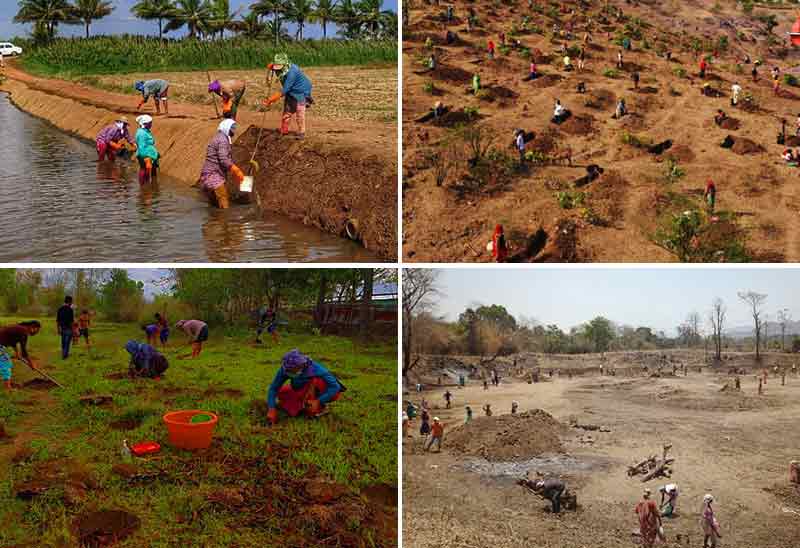- India
- Mar 28
Centre notifies revised MGNREGS wage rates
The Union ministry of rural development has issued a notification on the change in wage rates under the Mahatma Gandhi National Rural Employment Guarantee Scheme for the 2023-24 financial year.
The notification was issued under Section 6(1) of the Mahatma Gandhi National Rural Employment Guarantee Act (MGNREGA), 2005, that says the Centre may, by notification, specify the wage rate for its beneficiaries.
The wage hikes, which range from Rs 7 to Rs 26, will come into effect from April 1.
What is MGNREGS?
• Mahatma Gandhi National Rural Employment Guarantee Scheme (MGNREGS) is a demand driven wage employment programme, which provides for livelihood security by providing at least 100 days of guaranteed wage employment in every financial year to every rural household whose adult members volunteer to do unskilled manual work.
• In case employment is not provided within 15 days from the date of registration of the demand for work or the date from which work has been demanded in case of advance applications, whichever is later, the worker is entitled to a daily unemployment allowance.
• MGNREGS aims to strengthen the livelihood resource base of the rural households while creating productive assets.
• The Parliament passed the Mahatma Gandhi National Rural Employment Guarantee Act (MGNREGA) in August 2005. It came into force on February 2, 2006.
• MGNREGS was initially implemented in 200 districts and extended subsequently to other districts. At present, it covers over 700 districts.
• Wage rates for workers under the MGNREGA are notified and revised annually. MGNREGA wages are paid based on measurement of work done. Every state has its defined Schedule of Rates on the basis of which the work output is defined and used to calculate the wages for MGNREGA beneficiaries. The actual wage payable is calculated based on the output of the worker.
Objectives of the scheme:
i) Social protection for the most vulnerable people living in rural India by guaranteeing wage employment opportunities.
ii) Enhance livelihood security of the rural poor through generation of wage employment opportunities in works leading to creation of durable assets.
iii) Rejuvenate natural resource base of rural areas.
iv) Create a durable and productive rural asset base.
v) Empowerment of the socially disadvantaged, especially, women, Scheduled Castes (SCs) and Scheduled Tribes (STs), through the processes of a rights-based legislation.
vi) Strengthen decentralised, participatory planning through convergence of various anti-poverty and livelihoods initiatives.
vii) Deepen democracy at the grassroots by strengthening Panchayati Raj Institutions.
Achievements under MGNREGS
i) Geo-tagging of the assets: Geo MGNREGA Phase-I was rolled out on September 1, 2016 for geotagging of all completed works which started before November 1, 2017, under the scheme. Geo MGNREGA Phase-II was rolled out on November 1, 2017 and under this phase, the geo-tagging of assets is carried out in three stages — before initiation of work, during the work, and after completion of work. More than 5.2 crore assets have been geo-tagged (as on January 6, 2023) and made available in the public domain.
ii) Mandatory expenditure on agriculture and allied activities: As per the provision of the Act, the District Programme Coordinator is required to ensure that at least 60 per cent of the works to be taken up in a district in terms of cost shall be for the creation of productive assets directly linked to agriculture and allied activities through development of land, water, and trees. The expenditure on agriculture and allied activities is 68.5 per cent in FY23 (as on January 6, 2023).
iii) e-Payments: e-payments are done under MGNREGA using National Electronic Fund Management System (Ne-FMS)/ Electronic Fund Management System (e-FMS) for the payment of wages of workers directly to their bank/post office accounts. So far, total expenditure through NeFMS/e-FMS is 99.7 per cent.
iv) Direct Benefit Transfer: Under the scheme, 99 per cent of wage seekers are receiving their wages directly into their bank accounts. It is a big step towards transparency.
v) Aadhaar-based payment: 14 crore Aadhaar cards have been seeded in Management Information System (MIS) which is 92 per cent of total active workers (15.3 crore). A total of 7.9 crore workers have been linked to the Aadhaar Based Payment System.
vi) Cluster Facilitation Project (CFP): The Cluster Facilitation Project (CFP) has been rolled out in 300 blocks of the country, from April 1, 2020. It aims to ensure effective implementation of MGNREGA for accelerated development in 250 blocks of 117 aspirational districts and 50 blocks of other backward regions through better planning, monitoring and coordination by providing thematic experts in various domains at national, state, district and block level. CFP is operational in 29 states/UTs.
Manorama Yearbook app is now available on Google Play Store and iOS App Store


